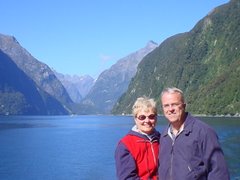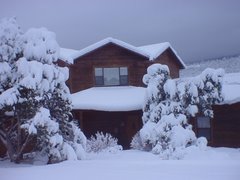This coast is a mecca for macho-surfers. Winter storms in the North Pacific send monstrous waves against this shore. In January, 1988, waves up to 40 ft. high were reported. I remember back in the early days of Wide World of Sports watching surfing contests at the Bonzai Pipeline, which is just a mile or so down the coast from here. Waves so tall a surfer can ride the face of the wave as the top curls over him. The big waves can hit as early as now, but so far, not this week.

Nevertheless, we've been repeatedly warned: stay out of the water. The bungalow manager said the waves aren't large right now, but they're still dangerous. The lady in the adjacent bungalow, when she saw me heading for beach, said: Be careful. Go in north of here so the current will bring you ashore near here rather than bashing you on the lava outcropping just below us. And to make it official, lifeguards have posted signs: Rip Current. No Swimming. (A rip current is a strongly outflowing current.) I went in to my ankles, alertly watching for the sneak rogue wave.
The folks next door are repeat visitors. Our bungalows are probably 20 feet above the water line and 75 yards back. The lady there said she's seen waves pounding in to the top of the beach, just out of reach of the ledge the bungalows are sitting on. The bungalows can vibrate, she said. I'm not sure I would hang around for the thrill.
Here's the view from the front window of our bungalow.

Here's a view from the beach. Our unit is the right half of the one-story building just to the left of the two-story building.

Those metal bands around the palm trees are to keep rats, yes, rats, from climbing up in the crown and making nests. We didn't see any rats and manager said he rarely had. Also, on Monday there was a crew trimming fronds and removing coconuts from these trees lest one fall on a guest. One chap climbed the trees and three or four others watched and cleaned up the trimmings.

Our Monday outing was an afternoon trip to the Dole Plantation. One of our gastronomic highlights so far was the fresh pineapple we were served at the airport hotel. We both said, Wow! Made for quite a scene in the restaurant. Made it imperative that we visit the source.
Here are some pineapple facts: Pineapples are planted by hand -- the top of the fruit is the seed for the new plant -- about 28,000 plants per acre. It takes about 20 months to produce the first fruit, another 14-15 months for the second. They harvest two crops in four years, or three in five years, then the plants are plowed under and a new crop planted. In Hawaii, of course, pineapples can be planted any time of year, so the crops are staggered. Plants are protected by black plastic and they are irrigated and fertilized as they grow. In its heyday over 90% of the world's pineapple crop came from Hawaii. Mr. James Dole bought a small island named Lanai and it was dedicated to pineapple growing.
On the way back fromDole we sidetripped through a couple of beach villages, Waialua and Haleiwa, the latter said to have many interesting shops and restaurants. Well, we missed them. We just saw a couple of surfer shops and a couple of eating establishments, if you include panel trucks serving shrimp and steak sandwiches. (Next day, Tuesday, though, I found businesses and we later went back in search of books.) We went on up the coast from Sunset Beach and did find Ted's Bakery, which I'd read about. It's a restaurant as well as a bakery -- a North Shore tradition. We brought dinner home and dined on our lanai.
Here's Monday's sunset, though I must say that Canon seems to have intensified the colors vs. what I saw with my eyeballs.

Tuesday morning I hiked to Kaena Point. That's the pointy thing on the NW shoulder of the island and it's the point of land seen in the sunset photo.

The writer of our Fodor’s Guide said that if she (I think) had only one day to spend in rural Oahu, she would "spend it walking the back road along the rocky shore at the island's northern tip." Good enough recommendation for me, even though I don't think she got the geography quite right. I read somewhere that Hawaiians don't use conventional direction indicators. More Fodor's: Kaena Point is where it is said that "the souls of the ancient dead leapt into the eternal darkness. ... It's a trek that will change your mind about Oahu being 'too crowded."
From the parking lot it is about a three-mile hike along a 4WD road to reach the point. The way is barren, no trees, but crashing surf on your right, steep hills on the left. Got the pictures of the point: Looking out. Looking back.


The timer on my camera caught me by surprise, which is why I’m in a semi-crouch -- not in pain.


The timer on my camera caught me by surprise, which is why I’m in a semi-crouch -- not in pain.
Signs at the point cautioned me about wildlife. One was the Monk Seal. I didn’t see any. I started to walk down to a little beach on the south side of the point and heard a snort. Looked to my right and a few feet away spotted a seal. He seemed to be in distress, unable to move, and I thought I saw blood in his tail area.

I had seen a couple of people working in the area and I sought one out and told her what I‘d seen. She said there’s a seal that hangs out in the area, he’s probably just sleeping, but I’ll report to another park person.

I had seen a couple of people working in the area and I sought one out and told her what I‘d seen. She said there’s a seal that hangs out in the area, he’s probably just sleeping, but I’ll report to another park person.
So, I headed back, conscience clear. At the gate into the Point Preserve area, a mountain bike rider caught up with me, also exiting. We talked a little bit about the wind -- strong tailwind coming out, headwind returning. I told him about the seal. Oh, he said, that’s probably number 040, called Tom. He sleeps 12 hours a day in that area. Laziest animal in the world. He went on to say that there are only about 1200 monk seals in the world, so I had had the fortune of seeing a very rare animal.
I asked about the albatross. The biker was wearing an Audubon Society t-shirt and was obviously a frequent visitor to K Pt. Signs said not to disturb albatross nesting areas and cables were strung along the paths to keep you away. The lady I had talked to about the seal said a few had arrived -- they were hanging out near the hill.
Mr. Aububon told me a lot more. He said he’d seen seven pairs -- young ones -- that morning. (I didn’t see any.) Albatrosses are big birds: they can have a wing span greater than 13 ft. -- largest of all birds. They live for 40-60 years and are monogamous. A chick born here, when mature enough, will migrate 1200 miles away and return to within 12 ft. of its nesting area.
Here's an article from a local website, http://sailhawaii.com/alba.html , about the albatross species found here.
Laysan albatross are very large birds. Their wingspan can reach to 13 feet (three meters) and they may weigh as much as 25 pounds (11 kilograms). Its range extends to most of the north Pacific Ocean.
Albatross live from forty to sixty years. They can stay out at sea for as long as five years before returning to the same island on which they were born. They have elaborate courtship dances, and once mated they tend to remain faithful to their mate. In adulthood they rendezvous each year with their partner at the same nest site. Nesting time is the only time they spend on land, and each year the pair stays just long enough to hatch and raise a single chick.
On land, albatross are very awkward and often have difficulty taking off and landing. This has gained them the nickname of "Goony Bird". Although albatross are so awkward on land, they are graceful and impressive in flight. An albatross in flight can be so perfectly attuned to wind conditions that it may not flap its wings for hours, or even for days, as it can sleep while flying. It takes advantage of the air currents just above the ocean's waves to soar in perpetual graceful motion.
On land, albatross are very awkward and often have difficulty taking off and landing. This has gained them the nickname of "Goony Bird". Although albatross are so awkward on land, they are graceful and impressive in flight. An albatross in flight can be so perfectly attuned to wind conditions that it may not flap its wings for hours, or even for days, as it can sleep while flying. It takes advantage of the air currents just above the ocean's waves to soar in perpetual graceful motion.
Albatross are so beautiful in the air that superstitious sailors believed they were the reincarnated spirits of dead sailors who were searching the oceans for their lost friends.

On the hike back to the car, I stopped at this mini-beach to cool my feet and contemplate the meaning of life. I later encountered a large group of hikers, many wearing a t-shirt proclaiming: Walk the Talk. There's the answer.

When I got back to Sunset Beach, I found Susie engaged in vigorous beach activities.

We left the next morning, made a stop at the Polynesian Culture Center, and found our abode for the night in Kailua.
More to come.
Cheers,

Susie and Rob







No comments:
Post a Comment